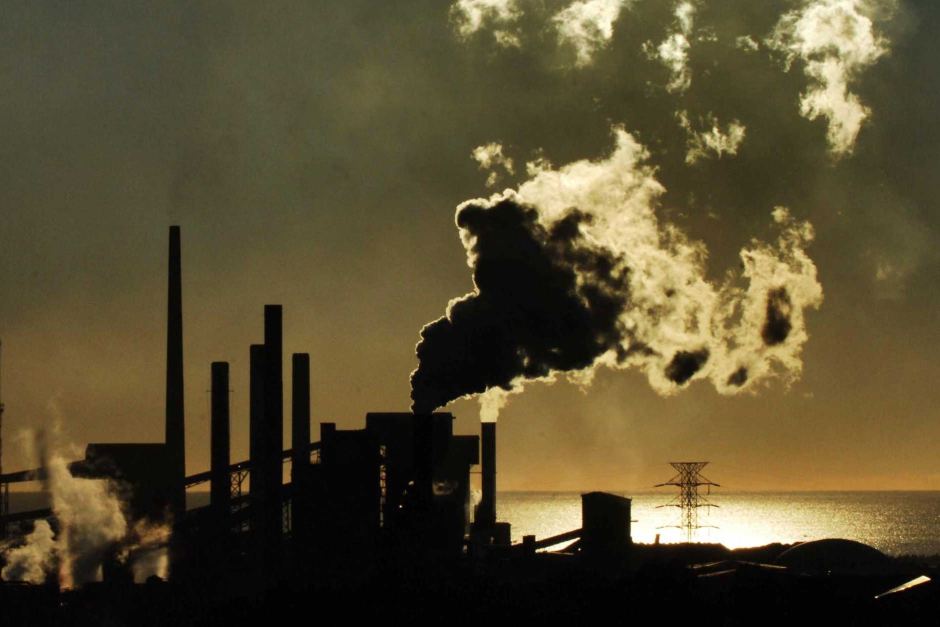Category: Mining (Rural) / Mining Industry / Business, Economics and Finance / Oil and Gas
BP Australia says pricing carbon one of the optimum methods of reducing emissions
Friday, 17 Feb 2017 12:56:13 | Babs McHugh

The Port Kembla industrial area and steel works in Wollongong, in New South Wales on June 1, 2007. (AAP: Dean Lewins)
Oil major BP Australia is factoring in a global carbon price in its future planning, the Australian-based managing director of exploration and production has confirmed.
Claire Fitzpatrick said a carbon price of $US100 a tonne of CO2 was a scenario used in the company's recent annual energy outlook publication.
"We used it in our economic outlook to 2035 in terms of a changing fuel mix and the transition to a lower carbon future," she said.
"We do put in a carbon price in investment decisions. They may not be in place now, but we assume there will be one so we put that into our economic modelling.
"We think that the world needs to drive changes and we believe one of the ways that may be easiest to do it, and I don't use that term lightly, is to price carbon."
However, Ms Fitzpatrick would not be drawn on what carbon price BP applied to existing or soon to come on stream projects.
"Those projects are subject to a carbon price, and my honest answer is I'm not sure if we have that publicly disclosed or not," she said.
Supply glut and new supplies continue downward price pressure
The seaborne gas market, LNG, is suffering from depressed prices, and Ms Fitzpatrick sees even greater downward pressure coming from new supplies.
"US shale gas has added a huge amount to the volume of gas that is available, and the US is starting to export so the amount of LNG available is increasing," she said.
"But a lot of Australian LNG, which has its price determined by the oil price, has already been sold under contracts and isn't looking for somewhere else to go."
It has often been claimed that the US has a domestic reservation policy, but Ms Fitzpatrick said that was not the case, and it had now actively entered the LNG market.
"The US hasn't had a domestic use policy. What they did have was a restriction on exports, but with the change in regulations and policy there, and the building of LNG terminals, they are now becoming a global player," Ms Fitzpatrick said.
Growing coal demand and gas prices
In its Energy Outlook to 2035, BP predicted a peak in coal use by the middle of the next decade.
However, there are still buyers in the market, especially in China, South East Asia and India.
After the destruction of nuclear power stations at Fukushima in Japan by a tsunami, the country massively increased imports of gas.
It continues to do so, but is also planning to continue with a program of building super-critical coal-fired power stations.
Ms Fitzpatrick said those decisions were based on a myriad of factors, and gas was still cost-competitive against coal.
"One factor is, what are Japan's objectives in terms of its fuel mix, and what role it wants to play in terms of carbon policy?" she said.
"If we look at India, by 2035 it will import 20 per cent of the world's coal production, two-thirds of which will go into power supply.
"So there are competing priorities: is coal cheaper? And what are we trying to do in terms of meeting COP 21 objectives [Paris Climate Agreement]?"
More stories on this issue:
- Australia won't meet Paris climate change targets: Finkel report
- Electricity industry pushes for carbon price to aid transition to clean energy system
- Climate scientists sad, frustrated as extreme weather becomes new norm
- Malcolm Turnbull's turnaround on renewable energy, from pro-carbon price to clean coal
- Renewable energy: Expert Danny Price says nation is heading for 'third-world power system'
- About Us
- |
- Terms of Use
- |
-
 RSS
RSS - |
- Privacy Policy
- |
- Contact Us
- |
- Shanghai Call Center: 962288
- |
- Tip-off hotline: 52920043
- 沪ICP证:沪ICP备05050403号-1
- |
- 互联网新闻信息服务许可证:31120180004
- |
- 网络视听许可证:0909346
- |
- 广播电视节目制作许可证:沪字第354号
- |
- 增值电信业务经营许可证:沪B2-20120012
Copyright © 1999- Shanghai Daily. All rights reserved.Preferably viewed with Internet Explorer 8 or newer browsers.




 Send to Kindle
Send to Kindle